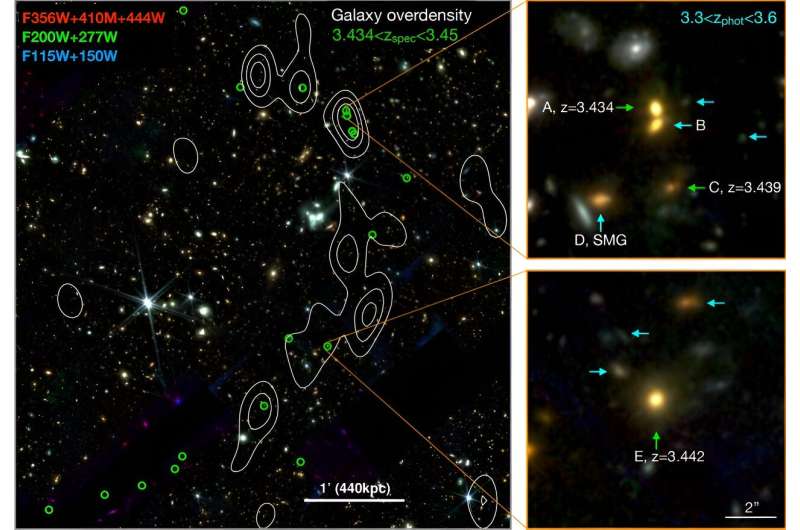November 15, 2023 report
This article has been reviewed according to Science X's editorial process and policies. Editors have highlighted the following attributes while ensuring the content's credibility:
fact-checked
preprint
trusted source
proofread
The 'Cosmic Vine': Astronomers discover a large structure that hosts at least 20 massive galaxies

An international team of astronomers reports the discovery of a large-scale structure that consists of at least 20 massive galaxies. The structure, dubbed "Cosmic Vine," has a size of about 13 million physical light years. The finding was detailed in a paper published Nov. 8 on the pre-print server arXiv.
Massive and dense structures of galaxies are perceived as progenitors of galaxy clusters—the most massive gravitationally-bound systems in the universe. Therefore, detecting new structures of this type and investigating them in detail is fundamental for our understanding of galaxy formation and evolution.
Now, a group of astronomers led by Shuowen Jin of the Technical University of Denmark, has detected a new object of this type—a large vine-like structure, hence its name Cosmic Vine. The structure was revealed at a redshift of 3.44, in the Extended Groth Strip (EGS) field observed with JWST. The observations were complemented by data from the Hubble Space Telescope (HST).
"In this paper, we report a large-scale structure 'Cosmic Vine' at z = 3.44 in the Extended Groth Strip (EGS) field covered by JWST surveys, and investigate two massive galaxies in the structure," the researchers wrote.
The observations show that Cosmic Vine is an extremely long and large structure—with a length of approximately 13.04 and a width of 0.65 million physical light years. Therefore, this structure is significantly larger than other compact galaxy groups and proto-clusters at redshifts above 3.0.
The study found that Cosmic Vine consists of at least 20 massive galaxies and six galaxy overdensities, contributing to a total mass at a level of 260 billion solar masses. The two most massive galaxies of the structure, designated Galaxy A and Galaxy E, are quiescent (with star-formation rates below 0.5 solar masses per year) and showcase bulge-dominated morphologies.
According to the paper, the obtained results suggest that Cosmic Vine is not a virialized system and that it is on the way to form a galaxy cluster. Furthermore, the findings confirm that massive quiescent galaxies can form in growing large-scale structures. The researchers added that it is possible that Galaxy E will become the brightest cluster galaxy (BCG) if it falls into the cluster core at later cosmic time.
The study also found that Galaxy A and E are likely quenched by merger-triggered starburst in the past 500 million years or active galactic nucleus (AGN) feedback before falling into the core of Cosmic Vine.
Summing up the results, the authors of the paper propose further investigation of quiescent cluster galaxies at high redshifts, which could be crucial in improving our understanding of how the largest structures in the universe form and evolve.
This may be possible with the help of the recently-launched ESA's Euclid space telescope as one of its scientific goals is to explore the structure and history of the cosmic web.
More information: Shuowen Jin et al, Cosmic Vine: A z=3.44 Large-Scale Structure Hosting Massive Quiescent Galaxies, arXiv (2023). DOI: 10.48550/arxiv.2311.04867
Journal information: arXiv
© 2023 Science X Network





















